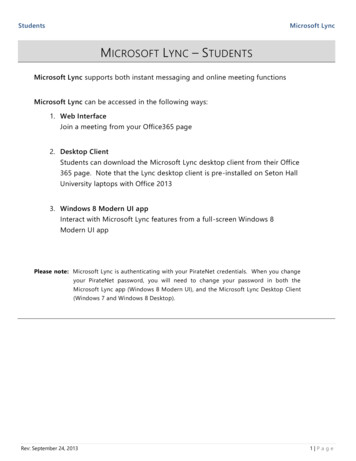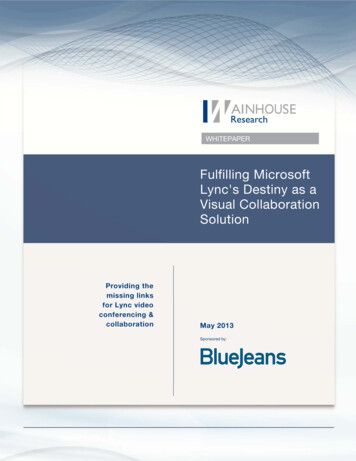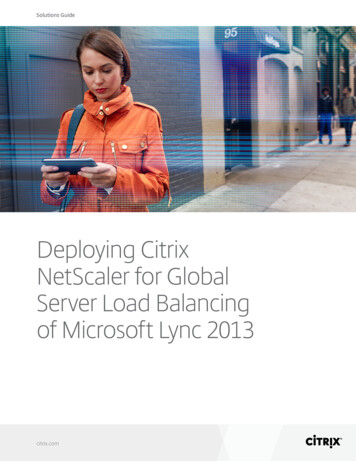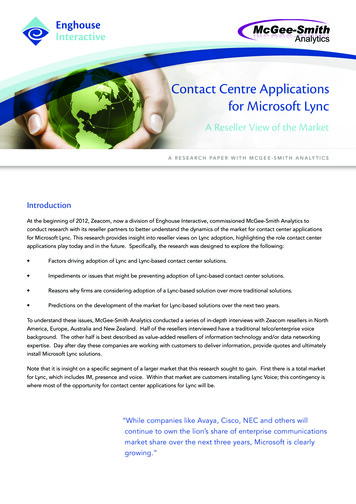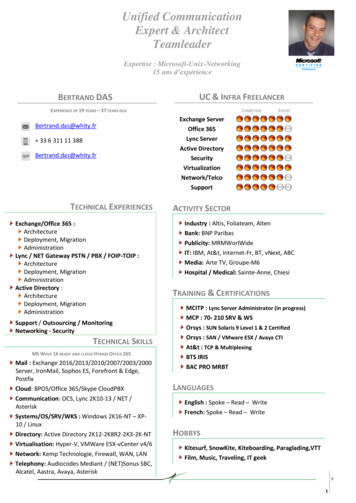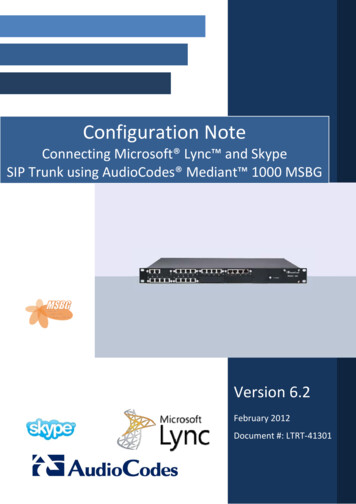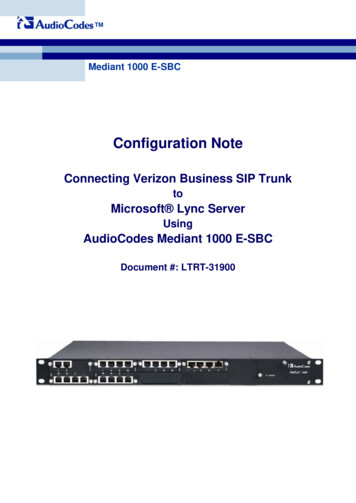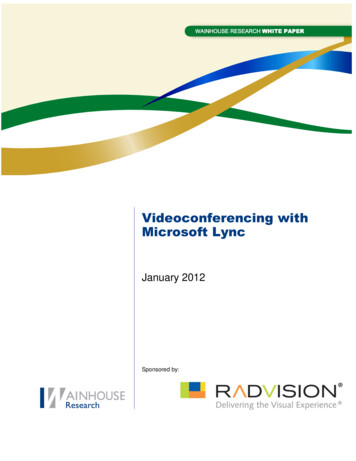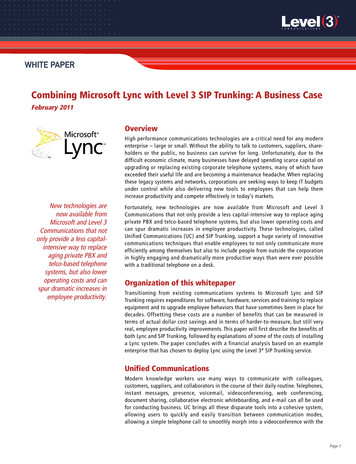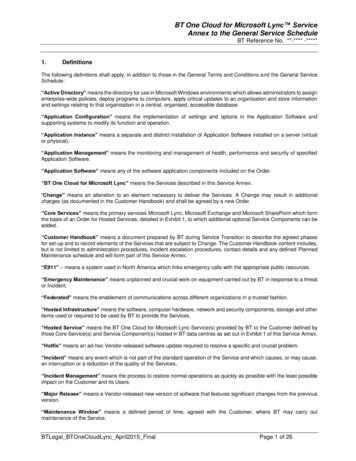
Transcription
BT One Cloud for Microsoft Lync ServiceAnnex to the General Service ScheduleBT Reference No. **-**** -*****1.DefinitionsThe following definitions shall apply, in addition to those in the General Terms and Conditions and the General ServiceSchedule:“Active Directory” means the directory for use in Microsoft Windows environments which allows administrators to assignenterprise-wide policies, deploy programs to computers, apply critical updates to an organisation and store informationand settings relating to that organisation in a central, organised, accessible database.“Application Configuration” means the implementation of settings and options in the Application Software andsupporting systems to modify its function and operation.“Application Instance” means a separate and distinct installation of Application Software installed on a server (virtualor physical).“Application Management” means the monitoring and management of health, performance and security of specifiedApplication Software.“Application Software” means any of the software application components included on the Order.“BT One Cloud for Microsoft Lync” means the Services described in this Service Annex.“Change” means an alteration to an element necessary to deliver the Services. A Change may result in additionalcharges (as documented in the Customer Handbook) and shall be agreed by a new Order.“Core Services” means the primary services Microsoft Lync, Microsoft Exchange and Microsoft SharePoint which formthe basis of an Order for Hosted Services, detailed in Exhibit 1, to which additional optional Service Components can beadded.“Customer Handbook” means a document prepared by BT during Service Transition to describe the agreed phasesfor set-up and to record elements of the Services that are subject to Change. The Customer Handbook content includes,but is not limited to administration procedures, incident escalation procedures, contact details and any defined PlannedMaintenance schedule and will form part of this Service Annex.“E911” – means a system used in North America which links emergency calls with the appropriate public resources.“Emergency Maintenance” means unplanned and crucial work on equipment carried out by BT in response to a threator Incident.“Federated” means the enablement of communications across different organizations in a trusted fashion.“Hosted Infrastructure” means the software, computer hardware, network and security components, storage and otheritems used or required to be used by BT to provide the Services.“Hosted Service” means the BT One Cloud for Microsoft Lync Service(s) provided by BT to the Customer defined bythose Core Service(s) and Service Component(s) hosted in BT data centres as set out in Exhibit 1 of this Service Annex.“Hotfix” means an ad-hoc Vendor-released software update required to resolve a specific and crucial problem.“Incident” means any event which is not part of the standard operation of the Service and which causes, or may cause,an interruption or a reduction of the quality of the Services.“Incident Management” means the process to restore normal operations as quickly as possible with the least possibleimpact on the Customer and its Users.“Major Release” means a Vendor-released new version of software that features significant changes from the previousversion.“Maintenance Window” means a defined period of time, agreed with the Customer, where BT may carry outmaintenance of the Service.BTLegal BTOneCloudLync April2015 FinalPage 1 of 26
BT One Cloud for Microsoft Lync ServiceAnnex to the General Service ScheduleBT Reference No. **-**** -*****“Minimum User Volumes” means the agreed minimum number of Users each month after Service Transition eitherincluded on the Order or agreed as part of the deployment plan prior to Service Transition and measured on theActive Directory,“Operating System” means the software installed on equipment managed by BT that operates the computer hardwareresources and provides the platform supporting the Application Software.“Operating System Management” means the monitoring and management of health, performance and security ofspecified Operating Systems, as set out in this Service Annex.“Patch” means a scheduled Vendor-released software update required to address bugs or security vulnerabilities.“Point Release” means a minor Vendor-released software update intended to address minor bugs and/or do minorsoftware cleanups.“Priority Level” means the assessment of an Incident’s business impact, or the priority required to fulfill a ServiceRequest.“Professional Services” means services provided by BT to the Customer as set out in this Service Annex for thepurpose of Service installation and configuration, consultancy, training and advisory and such other professional servicesas may be agreed by the Parties and included in an Order and which are subject to the Charges and BT’s standard termsand conditions.“Public IM Connectivity” means federation with public instant messaging networks such as AOL, MSN, and Yahoo.“Quest Software” means Quest Notes Migrator for Exchange and Quest Co-existence Manager for Notes.“Remote Managed Infrastructure” means the software, computer hardware, network and security components, storageand other items provided by the Customer and managed by BT to provide the Remote Managed Service.“Remote Managed Service” means the BT One Cloud for Microsoft Lync Service(s) provided by BT to manage theRemote Managed Infrastructure as set out in Exhibit 2 of this Service Annex.“Reporting Period” means a calendar month, beginning at 00:01 on the first day of the month.“Service Availability” means the measure of the availability of the Services as set out in the Service Levels of thisService Annex.“Service Component” means an element of the Services as described in this Service Annex and further detailed on theOrder.“Service Desk” means the BT support team acting as the point of contact for the Customer System Administrators toreport or seek updates in relation to Incidents and Requests.“Service Operations” means the ordinary, day to day, in-life activities carried out by BT.“Service Pack” means a periodic Vendor-released Application Software update that is an accumulation of Patches,Hotfixes and functionality enhancements.“Service Request” means a request by a Customer System Administrator for BT to modify the configuration of theService.“Service Transition” means BT’s delivery of the Services required by the Customer into live use.“SIP” means Session Initiation Protocol.“SMACs Process” means small moves, adds and changes, the process for which shall be as set out in the CustomerHandbook.BTLegal BTOneCloudLync April2015 FinalPage 2 of 26
BT One Cloud for Microsoft Lync ServiceAnnex to the General Service ScheduleBT Reference No. **-**** -*****“System Administrator” means an individual(s) authorized by the Customer to manage configurable aspects of theService including but not limited to management of Users.“Technical Configuration” means the activities carried out by BT to discover, design and implement the technicalfeatures of the Service.“Tier 1 Support” means the desk supporting the Users and is the responsibility of the Customer. Tier 1 Support deskmay escalate to Tier 2 Support.“Tier 2 Support” means the desk receiving escalations from Tier 1 Support.“Tier 3 Support” means the desk receiving escalations from Tier 2 Support, which is provided by BT via the BT ServiceDesk, who may escalate and manage Incidents with the Vendors.“User Administration” means tasks directly affecting User data or User access to the Services.“Vendor” means a vendor of Operating Systems and Application Software.“Vendor Support” means an arrangement providing access to Level 4 escalation support from a Vendor (or a Vendorauthorized support agent.2.Available ServicesBT One Cloud for Microsoft Lync Services are a collection of unified communication Service Components. AvailableService Components include Microsoft Lync core applications together with a number of supporting services. All ServiceComponents selected by the Customer’s solution will be listed on the Order.Upon request by the Customer more detailed product descriptions can be provided by BT in addition to the ServiceComponents described in the Exhibits. Product descriptions are for information purposes only and do not form part ofthe Agreement.BT One Cloud for Microsoft Lync consists of:2.1Standard Service2.1.1Setup and Delivery of BT One Cloud for Microsoft Lync;2.1.2and either:(a)BT One Cloud for Microsoft Lync Hosted Service if the Service is hosted at BT’s data centre(s), as setforth in Exhibit 1; or(b)BT One Cloud for Microsoft Lync Remote Managed Service if the Service is hosted at a RemoteManaged Infrastructure, as set forth in Exhibit 2.2.2Optional Services2.2.1The following optional Services may be supplied with the Service Components: Setup RightFaxThis option provides the deployment, installation, configuration and testing of the RightFax service in thedata centre. This does not include the procurement and installation of voice (PSTN) services into the datacentre. Setup Application or ApplianceThis option provides configuration, testing and acceptance into service of equipment or applications thatare either not hosted in the data centres or are not additional to the standard Service Components, whichcould be Customer Equipment. This includes, for example, the setup for devices such as gateways orSurvivable Branch Appliance (SBA) equipment on Customer Sites. All such equipment and applicationsBTLegal BTOneCloudLync April2015 FinalPage 3 of 26
BT One Cloud for Microsoft Lync ServiceAnnex to the General Service ScheduleBT Reference No. **-**** -*****will be referenced in the Order or any agreed Professional Services work order associated with theAgreement. BT Provided Equipment - Gateway Equipment SupplyThe supply and delivery of BT Provided Equipment is not included as part of the standard Service. Thisoption includes delivery of BT Provided Equipment and will be subject to the additional conditions for Saleof BT Provided Equipment as set out in the General Terms and Conditions. Quest Software SupplyQuest Software may be provided where the Customer is being migrated from Lotus Notes to MicrosoftExchange. The Customer is responsible for providing server infrastructure to host the Quest Software.2.2.2BT can provide other additional Professional Services. If the Customer requires such additional ProfessionalServices the Parties shall agree by Order the details of the deliverables of such Professional Service, subject tothe Charges and BT’s standard terms and conditions for such additional Professional Services.3.Delivery3.1Delivery is the set-up of the Service and includes, depending on the Service contracted:(a) Service Transition (applicable for both standard and optional Services),(b) Technical Configuration (only applicable for Hosted Service),(c) Acceptance (applicable for both standard and optional Services).3.2Service Transition. During Service Transition the Customer specific configuration details will be agreed for theServices. A Customer Handbook detailing the high level service design and the integration between theCustomer and BT for the provision of the Services will be developed. Service Transition ends on the OperationalService Date (OSD) for each Service. The Customer Handbook forms the reference document that sets out thekey characteristics of the ordered Services. The Customer Handbook is managed jointly in-life by the Customerand BT’s Account Manager.3.3Technical Configuration is only applicable for Hosted Services and is further described in Exhibit 1.3.4Acceptance. As part of the Customer Handbook, BT and the Customer shall jointly define the acceptancecriteria for the Service. The Operational Service Date (OSD) is the date that a Service is made available toand accepted, or is deemed accepted, by Customer and BT begins the Service Operations. On the OSD, theUsers’ of that Service are considered to be “in production” and the Minimum Period of Service shallcommence. The Service Transition project will end two (2) weeks after the OSD at which time the Customerwill receive a Service Transition closure report.4.BT Service Management Boundary (SMB)The SMB defines BT and Customer delivery, deployment and Service Operations. Specific responsibilities foreach BT One Cloud for Microsoft Lync Service are set forth in the relevant Exhibits.For the avoidance of doubt, the BT One Cloud for Microsoft Lync Service does not include the items listed below.If required these are the responsibility of the Customer unless ordered from BT under a separate Order:(a)Configuring Users to access the service from Active Directory in excess of the first 100(b)PBX, VOIP or voice service provider integration(c)WAN provision to the data centres(d)Quality of Service (QoS) or any WAN configuration such as IP routing(e)Internet domain registration(f)Customised E911 work(g)Video integrationBTLegal BTOneCloudLync April2015 FinalPage 4 of 26
BT One Cloud for Microsoft Lync ServiceAnnex to the General Service ScheduleBT Reference No. **-**** -*****(h)Integration with any third party unified messaging (UM) system.5.The Customer’s Responsibilities5.1In addition to the Customer responsibilities as set forth in each Exhibit, the Customer is responsible for:(a)(b)(c)(d)(e)(f)(g)(h)(i)(j)providing contact details for up to four (4) individuals who will be Customer System Administrators,authorized to make Service Requests or raise an Incident on behalf of the Customer. The Customer isresponsible for training its Customer System Administrators on how to interface with the Service;providing the User account names and passwords for configuration of the initial 100 Users at least one(1) month before the OSD;as part of the User Administration, configuring and extending the Customer’s own Active Directory sothat it conforms to an agreed specification for the installation of Lync Server should be carried out throughthe Customer’s own Active Directory (AD) administration tools. The Customer is responsible for addingUsers to the Service. Once the OSD has been reached for a particular Core service the Customer maystart to enable services through AD. From this point, applicable Charges will commence in line with theagreed deployment plans and any agreed minimum volume commitments;providing any necessary company information to the issuing authority of any required public (external)certificates;ensuring, at its own expense that its personal computers (“PCs”), mobile devices, handsets, headsets,webcams or accessories which may be required to access the Service are of sufficient technicalspecification to meet the requirements for the client applications as specified by Microsoft on its website;ensuring that Users have the appropriate client(s) installed on their desktop / mobile device(s);providing all information reasonably required by BT to provide the Service including any agreedintegration with the Customer’s own applications or voice services. The Customer is responsible forproviding and maintaining any such application(s) and for providing access to it as required by BT for theTerm of the Service;the creation, maintenance and design of all Customer information and ensuring that Customer complieswith any applicable legislation relevant to the provision of such customer information to BT;ensuring regulatory compliance of any network and/or voice services that are used in combination withthe Service;payment of all PSTN, SIP Trunking or mobile charges incurred when using the Service;5.2the Customer acknowledges that the Service does not qualify as a full replacement of a PSTN service and thatthe Customer’s Public Telecommunication Service Provider (“PTSP”) is responsible for all obligations applicable to theprovision of PSTN services. If the Service is used in conjunction with a third party SIP service, then the Customer mustprovide BT with written confirmation that it or its SIP supplier will comply with all regulatory obligations applicable to theprovision of PSTN and Voice over IP (VOIP) services;5.3If the Customer uses the enterprise voice capabilities of the Service, it is responsible for ensuring that its voiceservice provider provides network Calling Line Identity (“CLI”) in accordance with the regulatory provisions associatedwith outgoing and incoming voice traffic, the rules and guidelines for CLI handling commonly accepted in the carrierindustry, and that its voice service provider puts appropriate measures in place to enable Users to call the emergencyservices, to correctly identify the caller’s location and to provide such location information to the proper Public SafetyAnswering Point (PSAP). For the purpose of this section 5.3, the applicable voice service provider shall include providerof PSTN service or PSTN-equivalent VoIP service. The Customer acknowledges that it may not be able to use thelocation feature of Microsoft Lync to determine location for the purpose of calling emergency services.5.4By purchasing the Microsoft Lync enterprise voice capability Service Component, the Customer confirms andagrees that:(a)(b)(c)the Service may not offer all of the features generally expected from a conventional phone line;the Service may sometimes be unavailable as a result of things over which BT has no control, for example,the weather, power disruptions and failures of the Customer’s internet service provider (ISP) or broadbandconnection and that in such circumstances all services (including access to emergency services) will alsobe unavailable;connectivity to public emergency services is subject to the above and the phone number and locationdetails will be provided only to the extent that is technically feasible. As a result, Users may have to providetheir location information and phone number verbally to the relevant emergency services operator;BTLegal BTOneCloudLync April2015 FinalPage 5 of 26
BT One Cloud for Microsoft Lync ServiceAnnex to the General Service ScheduleBT Reference No. **-**** -*****(d)(e)(f)(h)where the Customer uses the Service outside of its users’ normal locations calls may not be connected tothe domestic emergency services upon dialling the appropriate emergency number;for each VoIP extension or trunk in use, Customer or Users must register the physical location where theywill be using the Service. Initial location will be registered as a part of subscribing to the Service. It is theCustomer or Users responsibility to maintain the accuracy of their location address if there are anychanges. If the Customer’s service desk does not update BT with changes through the (small moves andchanges process (SMACs) as defined in the Customer Handbook, it may not be possible for emergencyoperators and authorities to identify Users’ locations and phone numbers when they dial emergencyservices. When they dial emergency services they will need to state their location and phone numberpromptly and clearly, as emergency operators and authorities may not have this information;emergency operators and authorities may not be able to identify the User’s phone number in order to callback if CLI was not transmitted by the Customer’s voice service provider, the call is unable to be completed,is dropped or disconnected, or if Users are unable to speak to tell them the phone number and/or if theService is not operational for any reason. Emergency operators and authorities may also not be able tohold the line open in the event that Users disconnect the call;to inform all potential users of the Service of the above limitations and understands and accepts that theUsers should always have an alternative means of accessing emergency services.5.5BT shall not be liable for any failure of the Customer to comply with this section 5 or for issues in relation to theServices which arise from Customer’s failure to comply with this section 5 and the Customer shall indemnify BTfrom and against any claims or actions brought by its employees or Users against BT arising out of BT providingany Service Component in accordance with this Agreement.6.Charging Principles6.1The specific Charges for the Service and all Service Components will be detailed on the Order and are subjectto the payment terms as set out in the General Terms and Conditions.6.2For setup of BT One Cloud for Microsoft Lync Service the following Charges shall apply:ProductSetup for CoreServices or per Useronboarding setupSetup service forequipment,applications, oradditional ServiceDesk functions argeYesRecurringChargeNoYesNoDepending on theProfessional Service ordered.BTLegal BTOneCloudLync April2015 FinalNotesThe type of Setup for the Core Services willbe defined on the Order and will be basedon either a single one-off Charge for allUsers or a series of one-off Charges foreach User when they first access theService. Charging is also based on howmany Setup activities need to beperformed i.e. per Core Service or datacentre region.Charged per item.Additional Professional Services may berequired within the ServiceManagement Boundary of the Servicefor specific Customer integration orequipment supply.Page 6 of 26
BT One Cloud for Microsoft Lync ServiceAnnex to the General Service ScheduleBT Reference No. **-**** -*****6.3The recurring Charges structure for the BT One Cloud for Microsoft Lync Service depends on the type ofService – which for BT One Cloud for Microsoft Lync Hosted Service is described in Exhibit 1 and for BT OneCloud for Microsoft Lync Remote Managed Service is described in Exhibit 2.6.4Any licencing charges in respect of Application Software are subject to annual price variation during the termof this Agreement, depending on potential price changes of the applicable Vendor.6.5Unless specified otherwise on the Order, any Professional Services Charges will be calculated at the daily rateapplicable at the time the work is carried out and payable on completion of the work, or as otherwise agreed inwriting, together with any amounts owed to BT for expenses incurred.6.6Any requests for Changes to the Customer’s existing Order(s) for the Service will be subject to BT’s priorwritten agreement.7.Minimum Period of Service and Early Termination7.1Notwithstanding the General Service Schedule, each Order is subject to a Minimum Period of Service of 36months unless otherwise agreed in the Order.7.2If the Customer requests changes to the Customer’s existing Order(s) for the Service during the Minimum Periodof Service then the Parties may agree to enter into a new Order:a)b)on a new Minimum Period of Service; oron reviewed Charges if the Customer prefers to keep the same Minimum Period of Service as set out onthe existing Order(s).7.3At the end of the Minimum Period of Service, the Services shall continue thereafter until such time as terminatedby either Party in accordance with the General Terms and Conditions. Any renewed licenses for ApplicationsSoftware shall automatically result in a full year extension.7.4The provisions of the General Terms and Conditions and the General Services Schedule apply, if the Customerterminates one or more Service Components or if BT terminates the Service for breach by the Customer beforethe Minimum Period of Service has expired, and the recurring Charges per Site per month will be calculated asthe average of the recurring Charges of the terminated Services for the three months before notice of terminationis received. In addition, Customer will pay any outstanding license fees for the full current term of anyApplications Software.8.Application Management and Configuration8.1BT will provide monitoring and management of the Application
"Public IM Connectivity" means federation with public instant messaging networks such as AOL, MSN, and Yahoo. "Quest Software" means Quest Notes Migrator for Exchange and Quest Co-existence Manager for Notes. "Remote Managed Infrastructure" means the software, computer hardware, network and security components, storage

